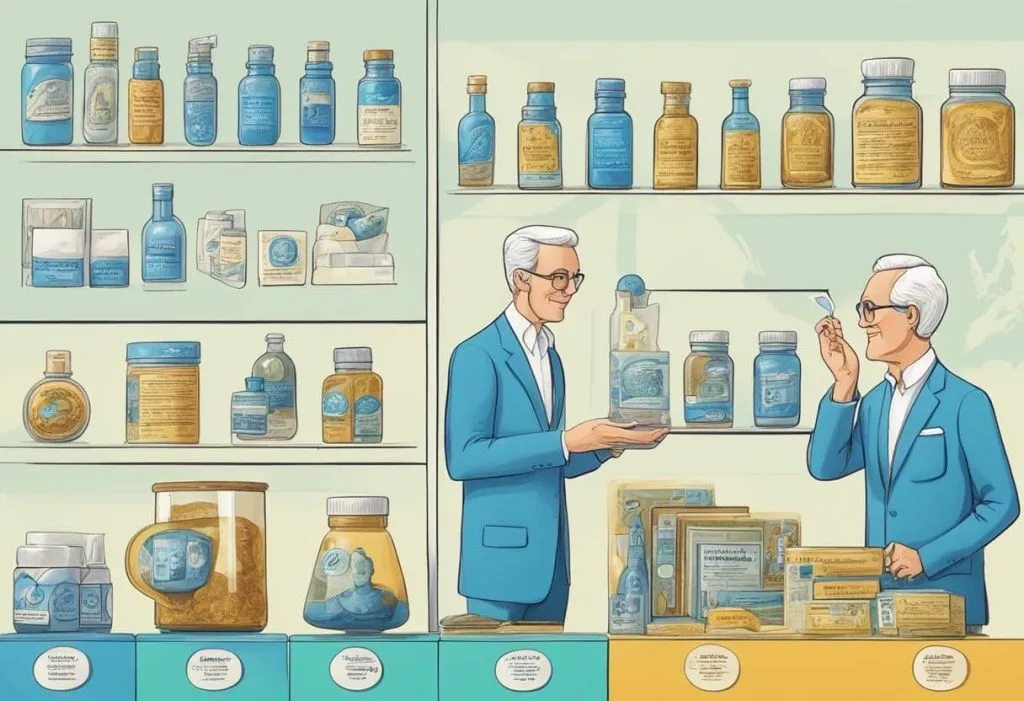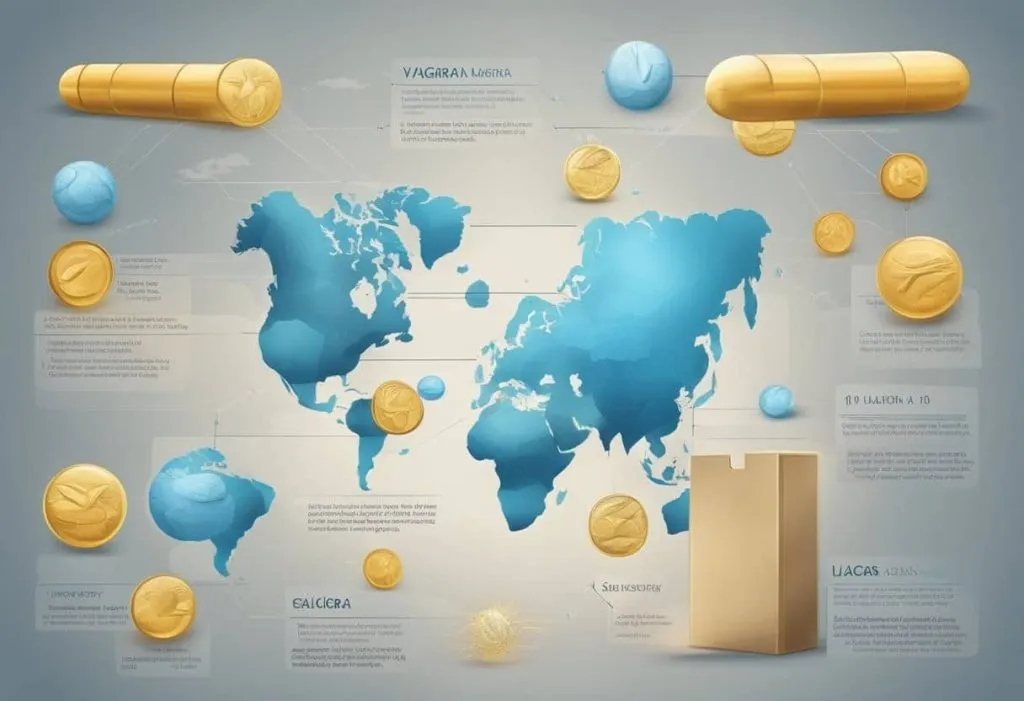Viagra is one of the most well-known drugs in the world, with a reputation that extends far beyond its original purpose. But how did this little blue pill become such a global phenomenon? The story of Viagra is one of scientific innovation, government regulation, and public fascination. From its early development to its current place in popular culture, the history of Viagra is a fascinating tale that touches on many aspects of modern life.
The Birth of Viagra Viagra was first developed in the early 1990s as a potential treatment for angina and hypertension. However, during clinical trials, researchers noticed an unexpected side effect: the drug seemed to improve erectile function in some male patients. This discovery led to a shift in focus, and the drug was eventually approved by the FDA in 1998 as a treatment for erectile dysfunction. Since then, Viagra has become a household name, with millions of prescriptions written every year.
Key Takeaways
- Viagra was originally developed as a treatment for angina and hypertension, but during clinical trials, researchers discovered its potential as a treatment for erectile dysfunction.
- Viagra was approved by the FDA in 1998 and has since become one of the most well-known drugs in the world.
- The history of Viagra touches on many aspects of modern life, including scientific innovation, government regulation, and popular culture.
The Birth Of Viagra

Viagra was first conceptualized as a treatment for angina, a condition that causes chest pain due to reduced blood flow to the heart. However, during clinical trials, researchers noticed an unexpected side effect – improved erectile function in male participants. This led to the development of Viagra as a treatment for erectile dysfunction (ED).
The compound that would become Viagra was discovered in the Sandwich laboratories of Pfizer Ltd in the UK in 1989. Initially known as UK-92,480, it was synthesized as part of a program aimed at developing drugs to treat hypertension and angina.
In 1996, Pfizer patented the compound and began clinical trials to test its safety and efficacy as a treatment for ED. The trials were successful, and in 1998, Viagra was approved by the US Food and Drug Administration (FDA) for the treatment of ED.
The introduction of Viagra was a major breakthrough in the treatment of ED, which was previously considered a psychological issue or an inevitable part of aging. The drug quickly became a global phenomenon, with 40,000 prescriptions written within a few weeks of FDA approval. The success of Viagra led to the development of other treatments for ED, such as Cialis and Levitra.
Today, Viagra is widely recognized as a cultural icon and has become synonymous with male sexual health. Despite its popularity, it is important to note that Viagra is a prescription medication and should only be used under the guidance of a healthcare professional.
Early Trials And Development

Initial Concept
The history of Viagra dates back to the early 1990s when Pfizer scientists were conducting clinical trials for a new drug called Sildenafil citrate. The initial concept was to develop a medication to treat angina, a heart condition that causes chest pain due to reduced blood flow to the heart.
During the clinical trials, the researchers noticed that the drug was not effective in treating angina, but it had an unexpected side effect – it caused erections in male patients. The scientists realized that the drug could be repurposed as a treatment for erectile dysfunction (ED), a condition that affects millions of men worldwide.
Clinical Trials
Following the discovery of the drug’s potential as a treatment for ED, Pfizer initiated clinical trials to evaluate its safety and effectiveness. In 1996, the company conducted the first phase of clinical trials involving 3000 patients with ED.
The trials showed that Sildenafil citrate was effective in treating ED, and it had few side effects. In 1998, the US Food and Drug Administration (FDA) approved the drug under the brand name Viagra as the first oral treatment for ED.
The approval of Viagra revolutionized the treatment of ED, which was previously considered a psychological issue or an inevitable part of aging. Viagra became a global phenomenon, and it is estimated that more than 64 million men worldwide have used the drug since its launch.
In conclusion, the discovery of Viagra was a serendipitous event that revolutionized the treatment of ED. The drug was initially developed to treat angina but was repurposed as a treatment for ED following unexpected side effects observed during clinical trials. The drug’s approval by the FDA in 1998 marked a significant milestone in the history of medicine and paved the way for the development of other treatments for ED.
FDA Approval And Market Entry

In March 1998, the U.S. Food and Drug Administration (FDA) approved sildenafil citrate, branded as Viagra, as a treatment for erectile dysfunction (ED) in men. It was the first oral medication of its kind to receive FDA approval. This approval was followed by approval from the European Medicines Agency (EMA) in September of the same year.
The approval of Viagra was a significant milestone in the treatment of ED, which had previously been treated with injections or surgery. The introduction of Viagra allowed for a less invasive and more accessible treatment option for men with ED.
Following FDA approval, Viagra was quickly launched in the United States and became a global phenomenon. In the first year of its release, Viagra generated over $1 billion in sales for Pfizer, the pharmaceutical company that developed and marketed the drug.
Viagra’s success was due in part to a massive marketing campaign that included television commercials, print ads, and sponsorship of major sports events. The drug’s iconic blue pill and diamond shape became instantly recognizable, and the term “Viagra” became synonymous with ED treatment.
Despite its success, Viagra was not without controversy. Some critics argued that the drug was overprescribed and that its marketing campaign encouraged recreational use. Others raised concerns about the potential side effects of the drug, including headaches, flushing, and vision changes.
Despite these concerns, Viagra remains one of the most widely prescribed medications in the world and continues to be a significant source of revenue for Pfizer.
Public Response And Impact

Medical Community
The medical community had mixed reactions to the release of Viagra. While some doctors were thrilled at the prospect of finally having a reliable treatment for erectile dysfunction, others were skeptical of the drug’s potential side effects and long-term safety. However, over time, as more and more studies were conducted and the drug’s safety profile became better understood, Viagra became widely accepted as a safe and effective treatment for ED.
General Public
The release of Viagra was a major cultural event, with media outlets around the world covering the drug’s approval and subsequent release. The general public was initially skeptical of the drug, with many people worried about the potential side effects and the possibility of addiction. However, as more and more people began using the drug and reporting positive results, public opinion began to shift.
Today, Viagra is widely recognized as a game-changing drug that has helped millions of men around the world overcome erectile dysfunction and improve their sexual health. While there are still some concerns about the drug’s safety and long-term effects, the overwhelming majority of people who use Viagra blue pill report positive results and few side effects. Overall, the impact of Viagra on the general public has been overwhelmingly positive, with many people praising the drug for its ability to improve their quality of life and restore their sexual confidence.
Viagra And Pop Culture

Since its introduction in 1998, Viagra has become a household name and a pop culture phenomenon. The little blue pill has been referenced in countless movies, TV shows, and songs, and has even become a punchline in jokes.
One of the earliest references to Viagra in pop culture was in the 1998 film “American Pie,” in which the main character’s father awkwardly tries to explain the drug to his son. The drug has since been mentioned in numerous other movies and TV shows, including “Sex and the City,” “The Hangover,” and “The Simpsons.”
Viagra has also been the subject of many jokes and parodies. In 1999, comedian Bob Dole famously starred in a Viagra commercial, poking fun at his own erectile dysfunction. The drug has also been the subject of numerous jokes on late-night talk shows and in stand-up comedy routines.
But Viagra’s impact on pop culture goes beyond just jokes and references. The drug has also been credited with changing the way we think about sex and aging. Before Viagra, erectile dysfunction was a taboo topic that was rarely discussed openly. But the drug’s success helped to break down those barriers and start a conversation about sexual health.
Today, Viagra remains one of the most recognized and popular drugs in the world. Its impact on pop culture and society as a whole is undeniable, and its legacy will continue to be felt for years to come.
Controversies And Legal Battles

Viagra has been the subject of several controversies and legal battles since its introduction. Some of the controversies include:
- Recreational use: Viagra has been used recreationally by people without erectile dysfunction, leading to concerns about its potential misuse and abuse. The drug has been nicknamed “the little blue pill” and has been associated with party culture and sexual promiscuity.
- Counterfeit drugs: The popularity of Viagra has led to the production of counterfeit drugs, which can be dangerous and ineffective. Pfizer, the manufacturer of Viagra, has taken legal action against counterfeiters and has implemented measures to prevent the production and distribution of counterfeit drugs.
- Pricing: Viagra has been criticized for its high price, which can be a barrier to access for some patients. In response to criticism, Pfizer has offered discounts and coupons for the drug and has introduced a generic version at a lower price.
- Patent disputes: Pfizer’s patent on Viagra has been the subject of legal disputes, with other pharmaceutical companies seeking to produce and sell generic versions of the drug. Pfizer has defended its patent in court and has reached settlements with some of the companies.
Overall, Viagra has had a significant impact on the pharmaceutical industry and on society as a whole. Despite its controversies, it remains a popular and widely used medication for the treatment of erectile dysfunction.
Viagra’s Global Expansion
Since its approval by the US Food and Drug Administration (FDA) in 1998, Viagra has enjoyed global recognition and sales. The little blue pill has become a household name, and its impact on the treatment of erectile dysfunction (ED) cannot be overstated.
Entry Into Emerging Markets
Viagra’s entry into emerging markets was not as smooth as its entry into established markets. In countries where cultural and religious factors play a significant role in sexual behavior, the drug faced stiff resistance. In some cases, the drug was even banned. However, with time, Viagra has gained acceptance in many of these markets.
One example is India, where the drug was initially banned due to cultural and religious reasons. However, in 2005, the Indian government granted Pfizer a patent for the drug, and it has since become widely available. In Africa, the drug has also gained acceptance, although access to it is still limited in some countries due to cost and regulatory issues.
Dominance In Established Markets
In established markets, Viagra has dominated the ED treatment market since its approval. The drug has faced competition from other ED treatments, such as Cialis and Levitra, but it has remained the market leader.
In the United States, Viagra’s market dominance has been challenged by the introduction of generic versions of the drug. In 2017, Pfizer lost its patent protection for Viagra, and generic versions of the drug became available. However, Pfizer has maintained a significant market share due to its brand recognition and marketing efforts.
In Europe, Viagra has faced regulatory challenges, with some countries requiring a prescription for the drug, while others do not. However, the drug remains widely available in most European countries.
Overall, Viagra’s global expansion has been a success, with the drug becoming a global phenomenon. Its impact on the treatment of ED has been significant, and its success has paved the way for other sexuopharmaceuticals.
The Rise Of Generic Viagra
Viagra’s patent expired in 2013, opening the door for the production of generic versions of the drug. Sildenafil, the active ingredient in Viagra, is now available in generic form, which has led to a significant decrease in the cost of the medication.
The introduction of low-cost generic sildenafil and the removal of prescribing restrictions led to a steep rise in the number of prescription items dispensed in England, from 1.3 million in 2012-2013 to 2.7 million in 2015-2016 [1]. This means that more people are able to access the medication, which can be life-changing for those who suffer from erectile dysfunction.
Generic versions of Viagra are now available in many countries, including the United States. These medications are just as effective as the brand-name drug, but they are significantly less expensive. This has made the medication more accessible to people who may not have been able to afford it otherwise.
The rise of generic Viagra has also led to increased competition in the market, which has driven down prices even further. This has been a boon for consumers, who are now able to purchase the medication at a fraction of the cost of the brand-name drug.
Overall, the rise of generic Viagra has been a positive development for consumers. It has made the medication more accessible and affordable, which has allowed more people to benefit from its effects. As a result, the medication has become a global phenomenon, helping millions of people worldwide.
[1] Three decades of Viagra – The Pharmaceutical Journal
Viagra In The Digital Age
The digital age has brought about significant changes in the way people access healthcare services. The rise of online pharmacies and telemedicine has made it easier for individuals to access prescription drugs such as Viagra. In this section, we will explore how Viagra has adapted to the digital age.
Online Pharmacies
Online pharmacies have become increasingly popular in recent years due to their convenience and accessibility. Patients can order prescription drugs such as Viagra from the comfort of their own homes and have them delivered directly to their doorstep. This has made it easier for individuals who may feel embarrassed or uncomfortable discussing their condition with a healthcare provider in person.
However, it is important to note that not all online pharmacies are legitimate. Patients should take caution when ordering prescription drugs online and ensure that they are purchasing from a licensed and reputable pharmacy. The FDA has issued warnings about the dangers of purchasing prescription drugs from unlicensed online pharmacies, as they may sell counterfeit or substandard drugs.
Telemedicine
Telemedicine has also played a significant role in making healthcare services more accessible. With telemedicine, patients can consult with healthcare providers remotely, either through video conferencing or phone calls. This has made it easier for individuals who may live in remote or rural areas to access healthcare services.
Telemedicine has also made it easier for individuals to obtain prescriptions for drugs such as Viagra. Patients can consult with a healthcare provider remotely and receive a prescription for Viagra if deemed appropriate. This has made it easier for individuals who may feel embarrassed or uncomfortable discussing their condition with a healthcare provider in person.
However, it is important to note that telemedicine is not a substitute for in-person healthcare services. Patients should still consult with a healthcare provider in person if they have any concerns or questions about their condition or treatment.
The Future of Viagra
As of 2023, Viagra continues to be a widely used medication for erectile dysfunction (ED) in men. While it has been over 25 years since its initial approval, it still remains the most popular ED medication on the market. Despite the availability of other PDE5 inhibitors, Viagra remains the go-to choice for many men due to its proven efficacy and safety.
Looking ahead, it is likely that Viagra will continue to be a popular treatment option for ED. With the increasing prevalence of ED worldwide, it is clear that there is still a significant need for effective treatments. As such, it is expected that Viagra will continue to be prescribed by healthcare providers for many years to come.
In addition to its continued use for ED, there is also ongoing research into other potential uses for Viagra. For example, some studies have suggested that it may be effective in treating pulmonary arterial hypertension (PAH), a condition that affects the heart and lungs. While more research is needed in this area, it is possible that Viagra may be approved for this use in the future.
Another potential use for Viagra is in the treatment of altitude sickness. Some studies have suggested that it may be effective in preventing or treating symptoms of altitude sickness, which can occur at high altitudes. Again, more research is needed in this area, but it is an interesting possibility for the future of the medication.
Overall, while Viagra has been around for over 25 years, it still has a bright future ahead of it. As research continues, it is possible that new uses for the medication will be discovered, making it an even more valuable tool for healthcare providers and patients alike.
Frequently Asked Questions
When was Viagra approved?
Viagra, also known as Sildenafil citrate, was approved by the FDA on March 27, 1998, as a treatment for erectile dysfunction (ED). Since then, it has become one of the most widely prescribed medications in the world.
What is the history of the blue pill VGR 100?
The blue pill with the imprint “VGR 100” is a brand-name Viagra tablet manufactured by Pfizer. The pill contains 100 milligrams of Sildenafil citrate, the active ingredient in Viagra. The blue color is simply a way for Pfizer to distinguish its product from other similar medications.
What was the main reason for developing Viagra?
The main reason for developing Viagra was to treat erectile dysfunction, a condition in which a man has difficulty achieving or maintaining an erection. The development of Viagra was a significant breakthrough in the treatment of ED, which had previously been treated with injections, vacuum pumps, and other less effective methods.
What are the side effects of Sildenafil 100mg?
Common side effects of Sildenafil 100mg include headache, facial flushing, indigestion, and nasal congestion. More serious side effects are rare but can include sudden vision loss, hearing loss, and an erection that lasts longer than four hours.
How does Sildenafil work (MOA)?
Sildenafil works by increasing blood flow to the penis, which helps a man achieve and maintain an erection. It does this by blocking an enzyme called phosphodiesterase type 5 (PDE5), which is responsible for breaking down a chemical called cyclic guanosine monophosphate (cGMP). cGMP is necessary for the smooth muscle cells in the penis to relax, allowing more blood to flow into the penis.
Is Sildenafil used for women?
While Sildenafil is primarily used to treat erectile dysfunction in men, it has also been used off-label to treat female sexual dysfunction. However, the effectiveness of Sildenafil in women is still a topic of debate, and it is not currently approved by the FDA for use in women.
Disclaimer: This content is for informational purposes only and should not be considered as medical advice. Always consult with a qualified healthcare professional before starting any medication or treatment for erectile dysfunction or following any point mentioned on this page and whole of our website adrclinic.co.uk

